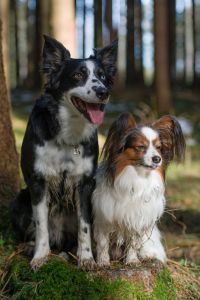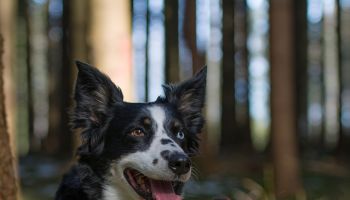Sometimes we don’t stop and think about our everyday household products and what negative effects that they could have on our pets.
The website, Rover provides us pet sitters and dog walkers for us pet owners, but they’re providing us with this 25 hazardous items list.
The list starts with the edible items in our house that are dangerous for our doggies… the NO-NO’s for dogs:
- Chocolate tops the food warnings, as caffeine and theobromine cause toxicosis and may bring seizures and death. Dark chocolate and cooking chocolate rank highest in harm.
- Coffee has caffeine too, so the toxic danger is an equal issue. What gets you up in the morning may seriously bring your dog down.
- Grapes sound like a great snack, except for the acute renal failure your dog might incur. Your kidneys won’t fail, but theirs might. Raisins are really just dried grapes, so they count too.
- Macadamia nuts are particularly poisonous to dogs, and it’s easy to forget if they’re in cookies and snacks you might be tempted to share.
- Onions kill canine blood cells and resulting Heinz Body Anemia can be life-threatening. Onion powder in food is enough to do this, so attention to ingredients is crucial.
- Garlic isn’t as dangerous as onions, and small amounts may even appear in some dog foods, but in larger quantity it’s just as damaging.
- Alcohol can cause the same liver and kidney damage it does to humans; it can also cause acidosis in your dog and end in cardiac arrest.
- Avocados fall into dispute by dog owners, but even if the Persin in avocados isn’t harmful to your dog, that big center seed is a choking hazard.
- Chicken bones can splinter and do all sorts of harm. In fact, cooked bones of any kind may be brittle and hazardous.
- Raw meat thrown to the dog is something you see in the movies, but our domesticated dogs aren’t wild anymore, and some are susceptible to salmonella and other bacterial poisoning.
It’s very easy to accidentally drop food on the floor when we’re cooking or baking, but try to remember the list of foods above.
Drug/Pharmaceutical dangers:
- Human pharmaceuticals like pain relievers might benefit bipeds, but our four-legged friends are truly a different animal. Acetaminophen in tylenol and other drugs may interfere with oxygen flow or do irreparable harm to the liver. Never use them, or any human medication, for dogs without veterinary consultation and direction.
- Veterinary pharmaceuticals may be prescribed for your pet, but that doesn’t mean they can’t overdose like we do on drugs. Oral doses are often flavored and hence attractive: if your dog finds the stash they might gobble it down. The use or dose for one size, breed, or species might not be fit for yours, so don’t borrow or take the drugs meant for another animal.
Chemical dangers:
- Insecticides that might be keeping the insect population down may seriously bug your dog. Even if the bait used in ant and roach traps might not be toxic, the traps themselves might be swallowed and cause choking. Snail, slug, and fly poisons may also be dangerous.
- Rodenticides use attractants that might also intrigue your canine companion, and the anticoagulants or phosphorus side effects meant to quell rat infestation can have devastating consequences for your dog.
- Cleaning products like bleach, window cleaners, and bathroom cleansers are often kept in low places your dog might get into. Even if a human child isn’t in residence, your quadruped might make the same childish mistakes.
- Heavy metals like lead and zinc can be toxic; paint chips, pennies and other household items that find their way into a dog’s stomach may mean medical issues.
- Fertilizer may not smell like food to you, but your dog might sniff out a feast that unfortunately includes a cocktail of phosphorus and nitrogen with chemicals for insect and weed problems. Cocoa mulch combines the dangers of fertilizer and chocolate.
- Detergents that keep your laundry clean may have ulcerous and fatal consequences for your dog.
- Antifreeze smells so sweet your dog might literally be dying to drink it.
- De-icers that deal with snow and slick driveways wind up on paws, and if those are licked, it can lead to poisoning.
The chemicals dangers is just like a danger for a child… a baby. You wouldn’t let your baby eat antifreeze or rat poison, so why would you give your pet easy access to them?
There are some odds and ends left on the list too…
The things you wouldn’t think could or would be consider dangerous too and surprisingly, rawhides is listed.
- Batteries might keep electronics going and going, but they won’t energize your pet. Mouth ulcers, throat and stomach issues can result from the acid.
- Toys with small parts might be great for older children, but dog toys are specific so that pieces aren’t swallowed or lodged in the throat. Balls and other playtime pieces that aren’t made for dogs—and your dog’s size—can be deadly.
- Fabric softener sheets might offer a tempting secondary use for controlling pet hair, but chemicals in them aren’t healthy for your dog. They may also like the smell and want to play with them like toys, but it isn’t wise.
- Plants may add an attractive quality to your home, but that beautiful smell or texture may tempt your pooch to lick or nibble. Daily Treat has a roundup of the 11 most poisonous plants for dogs, and the Humane Society has a large list of pooch-poisoning plants as well.
- Rawhide dog chews might seem crazy to consider dangerous, but they can host bacteria like Salmonella, which isn’t good for either of you. Monitor the storage, handout, use, and life of chews.
They’re also offering new dog parents and existing doggy parents a Care Sheet and Safety Checklist and such.
- Use a Care Sheet and Safety Checklist.
- Prep a pet first-aid kit for your home to be ready for emergencies you can handle.
- If you think your dog has ingested something poisonous, the ASPCA has a 24 hour poison control hotline.
If you have any other items that aren’t listed, please share it with us!
Via:rover.com

















